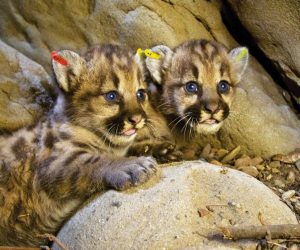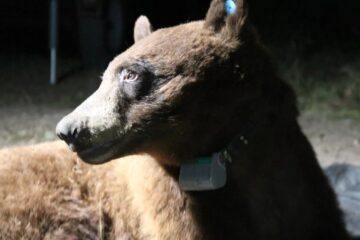Researchers discover two new mountain lion litters during “Summer of Kittens”
Difficult road ahead for Santa Monica Mountain cougar kittens
Source of this article, The Thousand Oaks Acorn, July 14, 2016
 National Park Service researchers recently discovered two litters of mountain lion kittens in the eastern Santa Susana Mountains. A total of five cubs, three females and two males, were ear-tagged and returned to their respective dens earlier this month.
National Park Service researchers recently discovered two litters of mountain lion kittens in the eastern Santa Susana Mountains. A total of five cubs, three females and two males, were ear-tagged and returned to their respective dens earlier this month.
The Santa Susanas are a large mountain range that provides a critical habitat connection between the Santa Monica Mountains to the south and Los Padres National Forest to the north.
“Despite the challenges mountain lions in this area face, the animals we’ve studied appear to be reproducing successfully,” said Jeff Sikich, a biologist with Santa Monica Mountains National Recreation Area. “The real challenge comes as these kittens grow older and disperse, especially the males, and have to deal with threats from other mountain lions and also road mortality and the possibility of poisoning from anticoagulant rodenticide.”

TOUGH BOYS AND GIRLS – Above, two kittens from the P-50, 51 and 52 litter appear bright-eyed and bushy-tailed. At left, P-48 and P-49. Ear tags are used by the park service to keep track of the animals. Photos courtesy of National Park Service
The first litter of cubs, tagged June 8, are two females known as P-48 and P-49. Their mother is P-35, an approximately 6-yearold female that the National Park Service has been tracking since April 2014.
Based on remote camera images, biologists suspect her previous kitten, P-44, did not survive into adulthood.
The second litter of kittens belongs to P-39, an approximately 5-year-old female researchers began tracking in April 2015. She gave birth to three cubs, a male known as P-50, a female known as P-51 and another male, P-52.
The den, discovered on June 22, was in a cave-like area hidden beneath boulders.
In both cases, the father is suspected to be P-38, based on GPS locations of him traveling and spending multiple days with P-35 and P-39 months before the cubs were born. Samples from the kittens were taken for genetic testing to determine paternity with certainty.
Researchers found the kittens’ den by analyzing the GPS locations transmitted from the mother’s collars. For the first three weeks after the kittens’ birth, the GPS points are typically localized in a cluster that is then used to determine the den’s location.
Even with GPS device in hand, the den can be difficult to find because of the thick brush and hidden crevices that mothers choose to hide their kittens in for protection.
These are the 10th and 11th litters of kittens marked by NPS biologists at a den site. Two additional litters were discovered when the cubs were already at least 6 months old.
Since 2002, the National Park Service has been studying mountains lions in and around the Santa Monica Mountains to determine how they survive in an increasingly fragmented and urbanized environment.
Courtesy of the National Park Service. Photos courtesy of National Park Service



0 Comments